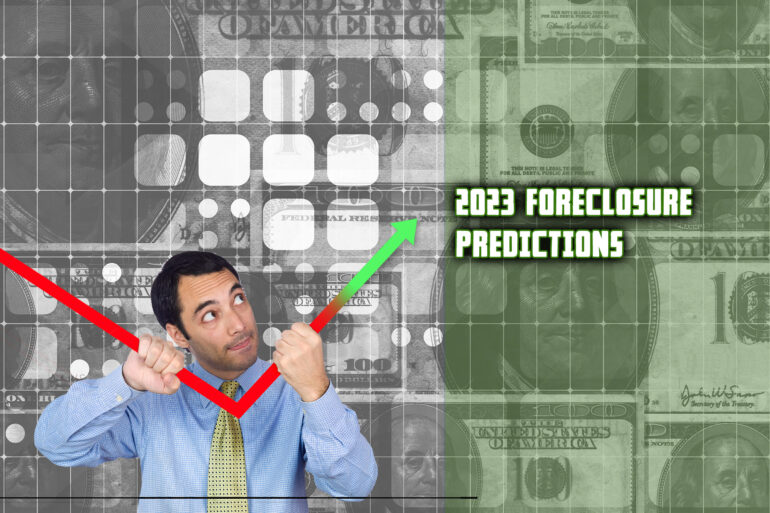2023 Foreclosure Predictions
We all quietly tiptoed into 2023 with the hopes for a better year. For the housing market, it looks like they threw a wild party, and we are left mopping up all the spilled drinks. What does that mean? Well, 2022 was a wild ride for the housing market.
Mortgage rates started 2023 at a multi-decade high, and housing inventory has been on lockdown. Many people purchased their homes at a low mortgage rate and are comfortable staying put, causing inventory for the housing market to be tight. This is the main reason why home prices are holding steady.
It has become increasingly hard for homebuyers to gain access to affordable housing.
We rolled into 2023 uncertain about where the housing market is leading. Let’s take a look at predictions for the housing market this year, and if we will have a spike in foreclosures.
What Is the Housing Market Forecast for 2023?
Due to the uncertainty of the economy at the moment, it may be easy to predict that 2023 will be filled with foreclosures.
The housing market had a few great years, and now, it appears that the market is trying to correct itself. However, this will be a slow process. At the moment, mortgage rates are still double what they were a year ago, while nationwide home prices are on a steady incline even with an overall decline in total sales. As a result, it has become increasingly hard for homebuyers to gain access to affordable housing.
According to the National Association of Realtors (NAR), “the median existing-home sales price rose to $370,700, an increase of 3.5% from one year ago.” These higher housing prices have taken their toll on those looking to buy a home, as mortgage loans hit an all-time low over the last 25 years.
From October to November, home sales decreased by 7.7%, which marks the 10th consecutive month of declining sales. Home sales are down 35% when compared to the sales recorded a year ago. This has some experts stating that the housing market has already hit its bottom.
With that said, mortgage rates are starting to stabilize around 6%, and experts believe the housing market will turn around in 2023.
Since unemployment rates are still low, we may continue to see low levels of foreclosure activity.
Will There Be a Lot of Foreclosures in 2023?
After the nationwide pandemic, foreclosures have been on a steady rise. According to ATTOM Data Solutions, foreclosures have hit their peak. Foreclosure rates are up 57% compared to a year ago, but they are down 5% from October 2022.
Foreclosures in November almost doubled compared to a year ago; however, they are 80% above pre-pandemic levels. Since unemployment rates are still low, we may continue to see low levels of foreclosure activity. In addition, delinquency payments on mortgages are lower than the historical averages.
The main difference when comparing our current housing crisis to the last is the fact that many homeowners have had a big boost in the value of their homes, meaning that the home has more equity than it is worth.
This means that a homeowner could choose to sell their home and walk away with some money after repaying their mortgage. However, not all homeowners have this ability, so the foreclosure rates could continue to increase in 2023.
Will Foreclosure Rates Go Up or Remain the Same in 2023?
Trends show us that foreclosure rates will continue to increase in 2023. Below, we will discuss the reasons.
COVID foreclosure protection laws expired at the end of 2021, which caused an influx of foreclosure activity in 2022.
Inflation can cause high foreclosure rates
Inflation can make it increasingly difficult for individuals to keep up with their current mortgage payments. Prices have increased on everything, including cars, homes, utilities, and groceries. The cost of living has gone way up, which results in homeowners being strapped for cash each month. This equates to the homeowner being unable to make mortgage payments, resulting in foreclosure.
How does a recession affect foreclosure rates?
As history shows, recessions tend to cause foreclosure rates to increase due to job layoffs, which can result in homeowners defaulting on their mortgages. With a recession, you will find many families struggling to meet daily necessities, and this directly results in bills becoming delinquent including mortgages.
COVID-related foreclosure protections have expired
COVID foreclosure protection laws expired at the end of 2021, which caused an influx of foreclosure activity in 2022. These laws were only temporary, so it was only a matter of time before foreclosure rates normalized.
Lenders offer various options to help homeowners get caught up or even skip a payment. However, even with this assistance, some individuals will have issues when it’s time to resume making mortgage payments.
How High Will Foreclosure Rates Go?
Currently, foreclosure rates are predicted to remain lower than pre-pandemic levels. This will continue until about mid-way through 2023. You may be wondering why foreclosure rates are predicted to remain lower than those seen pre-COVID.
Mortgage interest rates have increased to around 7%, which is a large increase compared to the 3% a year ago. An increase in interest rates will typically cause potential buyers to shy away from purchasing a home.
High-interest rates mean a larger monthly mortgage payment. This is something that a lot of individuals are not able to cope with. As a result, people will stop seeking mortgages, and the foreclosure rates will decrease.
Foreclosure Rates By State in 2023
Historically speaking, some states are more affected by foreclosure rates than others. According to ATTOM, “one in every 4,580 housing units had a foreclosure filing in November. States with the highest foreclosure rates were again: Illinois (one in every 2,401 housing units); Delaware (one in every 2,736 housing units); New Jersey (one in every 2,916 housing units); South Carolina (one in every 3,195 housing units); and Wyoming (one in every 3,237 housing units).”
The report also said, “lenders started the foreclosure process on 20,686 U.S. properties in November, down 5 percent from last month but up 98 percent from a year ago.”
Trying to predict which states will have the highest foreclosure rates in 2023 is not easy. High foreclosure rates will depend on employment, homeowner protection laws, and the housing market.









This is the most misleading, negative, out-of-touch article I have ever read about real estate. What state, country or planet are you talking about? Real estate is “local” so whatever is happening where you live, is not happening everywhere. For example, in Florida, real estate is still in high demand, price are still going up, and homes are still selling. Foreclosures are practically non-existent because there is no reason for a foreclosure when homes are so easy to sell. Also, you state interest rates are at an all time high when nothing could be further from the truth. If you did your homework, you would learn that they are actually pretty low compared to historical interest rates. What is the highest mortgage interest rate in history?
The highest mortgage rate in the last 30 years was in 1994, when the average 30-year rate was at 8.38%, according to Freddie Mac. In 1992, however, the average 30-year rate was 8.39%. These are slightly above the long-term average mortgage rate of just under 8%, since Freddie Mac started keeping records in 1971.
Although rates are not that much above the historical averages, they are up and triple what they were last year and over the historical average for the previous few decades. The article had a misprint, and it was corrected to a “multi-decade high,” as you and other readers pointed out the error.
Although there are fewer foreclosures today than five years ago, there are still plenty of foreclosures; you can see them all listed here:
https://propertyonion.com/property_search/